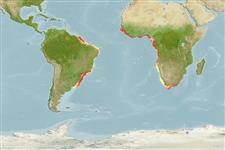Common names from other countries
>
Perciformes/Bembropoidei (Duckbill flatheads) >
Bembropidae (Duckbill flatheads)
Etymology: Bembrops: Greek, bembras, -ados = a kind of anchovy m+ Greek, ops = appearance (Ref. 45335); heterurus: Specific name probably from the Greek 'heteros' meaning different and 'oura' meaning tail..
Environment: milieu / climate zone / depth range / distribution range
Écologie
marin démersal; profondeur 50 - 400 m (Ref. 6948), usually 80 - 200 m (Ref. 47377). Deep-water; 12°N -
Western Atlantic: off Rio de Janeiro, Brazil to Uruguay. Eastern Atlantic: Mauritania to the extreme northern waters of Namibia (Ref. 6948, 27121). The eastern Atlantic form referred to as Bembrops heterurus is unlikely to be conspecific with the Brazilian form, thus further taxonomic study is needed to clarify this situation (Ref. 6948).
Taille / Poids / Âge
Maturity: Lm ? range ? - ? cm
Max length : 28.0 cm TL mâle / non sexé; (Ref. 6948); common length : 20.0 cm TL mâle / non sexé; (Ref. 2683)
Épines dorsales (Total): 6; Rayons mous dorsaux (Total): 14-15; Rayons mous anaux: 16 - 18. Color in alcohol light yellowish to yellowish brown dorsally, light yellowish brown to creamy brown ventrally. Upper lobe of caudal fin elongated at an acute angle. Snout relatively short, 1.0-1.4x eye diameter. Scales on lateral and dorsal surfaces of snout including area in front of eye. Upper jaw extending behind anterior margin of eye but not reaching its mid-line. Maxillary tentacle short. Lateral line descending gradually along dorsal edge of pectoral fin, separated from origin of first dorsal fin by 4 or 5 rows of scales, from origin of anal fin by 6 or 7, and from insertion of anal fin by 3-5. Pectoral fin moderately rounded. Lower lobe truncate or rounded (Ref 13203).
Found on soft bottoms of the continental shelf and feeds on crustaceans and fishes (Ref. 3656).
Life cycle and mating behavior
Maturité | Reproduction | Frai | Œufs | Fécondité | Larves
Das, M.K. and J.S. Nelson, 1996. Revision of the percophid genus Bembrops (Actinopterygii: Perciformes). Bull. Mar. Sci. 59(1):9-44. (Ref. 13203)
Statut dans la liste rouge de l'IUCN (Ref. 130435)
CITES (Ref. 128078)
Not Evaluated
Menace pour l'homme
Harmless
Utilisations par l'homme
Pêcheries: commercial
Plus d'informations
RéférencesAquacultureProfil d'aquacultureSouchesGénétiqueElectrophoresesHéritabilitéPathologiesTraitementMass conversion
CollaborateursImagesStamps, Coins Misc.SonsCiguateraVitesseType de nageSurface branchialeOtolithesCerveauxVision
Outils
Articles particuliers
Télécharger en XML
Sources Internet
Estimates based on models
Preferred temperature (Ref.
115969): 13.9 - 24.3, mean 16.8 (based on 91 cells).
Phylogenetic diversity index (Ref.
82804): PD
50 = 0.5000 [Uniqueness, from 0.5 = low to 2.0 = high].
Bayesian length-weight: a=0.00447 (0.00244 - 0.00818), b=3.08 (2.92 - 3.24), in cm Total Length, based on LWR estimates for this species & (Sub)family-body (Ref.
93245).
Niveau trophique (Ref.
69278): 4.0 ±0.2 se; based on diet studies.
Fishing Vulnerability (Ref.
59153): Low vulnerability (18 of 100).
